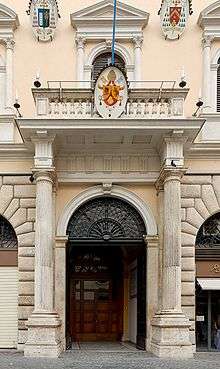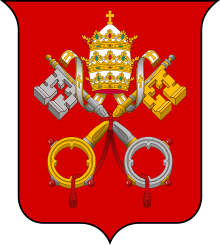Pontifical Ecclesiastical Academy

The Pontifical Ecclesiastical Academy (Latin: Pontificia Ecclesiastica Academia, Italian: Pontificia Accademia Ecclesiastica) is one of the Roman Colleges of the Catholic Church. The academy is dedicated to training priests to serve in the diplomatic corps and the Secretariat of State of the Holy See.
Despite its name, the Pontifical Ecclesiastical Academy is not one of the ten Pontifical Academies of the Holy See.
The patron of the Pontifical Ecclesiastical Academy is Saint Anthony the Great.
History
The diplomatic service of the Holy See can be traced back to 325 AD when Pope Sylvester I sent legates to represent him at the First Council of Nicaea. The academy was created as the Pontifical Academy of Ecclesiastical Nobles in 1701 by Abbot Pietro Garagni, in close collaboration with Blessed Sebastian Valfrè of the Turin Oratory.[1]
The Academy was forced to close between 1798 and 1803, the first years of the French occupation of Rome.
Function
Located inside Palazzo Severoli on the Piazza della Minerva in central Rome, the Pontifical Ecclesiastical Academy trains Catholic priests sent by their bishop from different parts of the world to study ecclesiastical and international diplomacy, particularly in order that the alumni may later be selected to serve in the Diplomatic posts of the Holy See—ultimately as a papal nuncio, or ambassador. Many leaders of the church have been alumni of the academy, including Popes Clement XIII, Leo XII, Leo XIII, Benedict XV, and Paul VI.[2]
Students spend four years at the academy; two years earning a licentiate in canon law (J.C.L.) from a Roman University (such as the Pontifical Gregorian University), then two years earning a doctorate in canon law (J.C.D.). If the students that have been recruited already have a J.C.D. then their time at the PEA is shortened to two years. The courses are usually in diplomatic history, languages and diplomatic writing and are considered not to be academic, but rather focus on the practical skills needed to serve as a diplomat. By the end of his studies, each student has to possess a working knowledge of at least two languages in addition to his mother tongue.[3]
The President of the academy is Archbishop Giampiero Gloder, who was previously an official in the Secretariat of State of the Holy See. He succeeded Archbishop Beniamino Stella on September 21, 2013, when Archbishop Stella was named by Pope Francis as the Prefect of the Congregation for the Clergy.[4]
Presidents
- Matteo Gennaro Sibilia (1701–1704)
- Francesco Giordanini (1704–1720)
- Pellegrino De Negri (1721–1728)
- Tommaso Giannini (1729–1739)
- Girolamo Formaliani (1739–1742)
- Angelo Granelli (1742–1744)
- Pier Matteo Onorati (1744–1762)
- Innocenzo Gorgoni (1763–1764)
- Paolo Antonio Paoli (1775–1798)
- Vincenzo Brenciaglia (1802–1814)
- Giovanni Giacomo Sinibaldi (1814–1843)
- Giovanni Battista Rosani (1843–1847)
- Giuseppe Cardoni (1850–1873)
- Venanzio Mobili (1873–1875)
- Odoardo Agnelli (1875–1878)
- Placido Maria Schiaffino (1878–1884)
- Domenico Ferrata (1884–1885)
- Luigi Sepiacci (1885–1886)
- Francesco Satolli (1888–1891)
- Augusto Guidi (1892–1894)
- Filippo Castracane degli Antelminelli (1895–1898)
- Rafael Merry del Val y Zulueta (1900–1903)
- Francesco Sogaro (1903–1912)
- Giovanni Maria Zonghi (1914–1941)
- Paolo Savino (1941–1959)
- Giacomo Testa (1959–1962)
- Gino Paro (1962–1969)
- Salvatore Pappalardo (1969–1970)
- Felice Pirozzi (1970–1975)
- Domenico Enrici (acting president; 1974–1975)
- Cesare Zacchi (1975–1985)
- Justin Francis Rigali (1985–1989)
- Karl-Josef Rauber (1990–1993)
- Gabriel Montalvo Higuera (1993–1998)
- Georg Zur (1998–2000)
- Justo Mullor García (2000–2007)
- Beniamino Stella (2007–2013)
- Giampiero Gloder (since 2013)
Non-graduate diplomats
A small number of diplomats currently represent the Holy See but have not been through the formal academic and practical training of the PEA. Examples of these diplomats are Michael Louis Fitzgerald, Silvano Maria Tomasi, Charles John Brown, Aldo Giordano Paul Mounged El-Hachem, Michael August Blume, S.V.D. and Alfred Xuereb.
See also
References
- ↑ "Cenni Storici" (in Italian). Holy See. Retrieved 8 April 2015.
- ↑ "Pontefici ex-alunni (Italian)". Holy See. Retrieved 2008-01-24.
- ↑ "An Interview with Archbishop Migliore", St. Thomas College, Sant Paula, California
- ↑ "Archived copy". Archived from the original on 25 September 2013. Retrieved 21 September 2013.
External links
Coordinates: 41°53′53″N 12°28′38″E / 41.89806°N 12.47722°E

